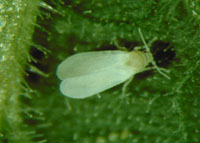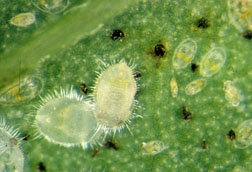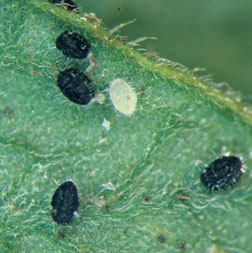by W.S. Cranshaw* (6/13)
Quick Facts…
- Greenhouse whitefly is a common pest of house plants and greenhouse plants. In summer, it can become established in the garden, affecting vegetables and flowers.
- It does not survive outdoors in areas of freezing winters, such as Colorado. Winter infestations may persist on indoor plants.
- Horticultural oils and neem are two of the best controls for the immature stages. Pyrethrins and related pyrethroid insecticides are recommended for control of adults.
- Colored sticky traps and certain biological controls can assist in whitefly control.
 |
Figure 1: Adult greenhouse whitefly. |
The greenhouse whitefly, Trialeurodes vaporariorum, can be a common insect pest in greenhouses and on house plants and garden plants during the summer. This insect has a host range of more than 250 ornamental and vegetable plants. Poinsettia, begonia, nicotiana, aster, calendula, cucumber, lantana, tomato, grape, ageratum, bean and hibiscus are commonly infested.
The greenhouse whitefly sucks sap from the plant, primarily from the phloem. Heavy infestations cause decline of plant vigor. Stunting, yellowing of foliage and premature leaf drop are among the symptoms of injury. Whiteflies excrete sticky honeydew during feeding. This detracts from plant appearance and allows gray sooty mold fungi to grow on the foliage.
In recent years, a second whitefly has become established in some Colorado greenhouses: the silverleaf whitefly, Bemisia argentifolii. This species also is sometimes known as the sweetpotato whitefly Strain B or the “poinsettia whitefly.” It has become endemic in the southwestern United States and in Florida. There it causes serious damage to crops and ornamental plants. It is far less common on house plants than the greenhouse whitefly.
Life History and Habits
 |
Figure 2. Greenhouse whitefly, hatched eggs and nymphs. |
The greenhouse whitefly is a tropical/subtropical species that cannot overwinter outdoors in Colorado. Freezing temperatures kill it and the lack of host plants prevents its survival except under highly protected conditions. Although whiteflies produce several generations on a variety of garden plants during the summer (notably tomato, pepper, and cucumber), year-round infestations are possible only indoors.
The familiar form is the white, winged adult. Because of the insect’s mobility, most infestations come from adult females moving to new plants. When they find a suitable plant, they insert their mouthparts into the phloem. They usually remain in place for several hours as they lay a series of eggs in a semicircular pattern on the plant surface. The creamy yellow eggs darken after 24 hours. Most eggs are laid on the newest leaves.
Nymphs emerge within five to seven days. They move a short distance before flattening themselves against the leaf to feed. All remaining immature stages of the greenhouse whitefly are immobile.
 |
Figure 3. Greenhouse whitefly nymphs. Black forms are parasitized. |
There are three nymphal stages that feed on the plant, spaced at two-to four-day intervals. A nonfeeding “pupal” stage follows, lasting almost a week. All the immature stages are inconspicuous and easily overlooked. They are usually pale, almost translucent, and are superficially similar to certain scale insects. Late-stage nymphs and pupae may also have thin
waxy threads that can resemble those produced by mealybugs.
Adult whiteflies emerge from a slit that develops along the back of the pupal skin. Ratios of male to female whiteflies vary. More females occur in late spring than in winter. Under favorable conditions, a generation of the greenhouse whitefly takes three to four weeks to complete. Each female can lay 400 eggs over a period of up to two months. Usually they produce
many fewer eggs.
Control of Whiteflies
Prevention is the best management. Infestations originate only from infested plant materials. Carefully check all new plants and quarantine them before moving them into a room with susceptible plants.
Once the insects are established in a greenhouse, a host-free period can starve them. This might mean removing for at least two weeks any plants on which the whitefly can survive. Pay careful attention to weed control, because weeds may allow whiteflies to survive even if suitable crops are not present.
Traps
Adult whiteflies are highly attracted to yellow and white. They often are found on lighter colored foliage. To capture the winged whiteflies, place appropriately colored sticky traps just above susceptible plants or around edges of plantings. These traps usually are flat sheets or tape coated with a sticky material that can hold the insects. Several commercial products designed specifically for insect capture are available from garden catalogs and greenhouse suppliers. Trade names include Tangle footR, Stick-em SpecialR and Tack-trapR. A heavy-weight oil or grease is an acceptable alternative. Some manufacturers make yellow sticky cards or tapes.
Yellow sticky traps are used both to monitor whitefly populations and to help suppress populations. Monitoring is the most common use, to detect movement of whiteflies into a greenhouse or increases in populations. For whitefly control, place many sticky tape or other traps around the planting.
Biological Controls
The small parasitic wasp, Encarsia Formosa, has long been used as a biological control for greenhouse whitefly. It develops within the whitefly nymphs. Young whiteflies turn black and die in several days. However, temperatures must average (day plus night) 72 degrees F. Many garden catalogs carry whitefly parasites.
More recently, another parasitic wasp has been marketed, Eretmocerous californicus. It appears to have some advantages over Encarsia formosa. Adults of E. californicus kill many whiteflies in the process of “blood feeding.” This occurs when the whitefly nymphs are punctured with the wasps’ ovipositors. Instead of laying an egg, the adult feeds on blood from the wound. E. californicus is also much more effective against the silverleaf whitefly.
Insecticides
Insecticidal control can be difficult because the insect is resistant to most insecticides. Furthermore, egg and the nonfeeding pupal stages are generally not susceptible to insecticides that can kill adults and nymphs. Thus repeated applications are usually required.
The most effective insecticide for whitefiles is imidacloprid. This has systemic properties and is usually used as a soil application, taken into the plant via the roots. It is not registered for most home grown vegetables but can be used in flower beds and houseplants.
Horticultural oils (e.g., SunSpray) are one of the most effective whitefly controls available for use on house plants. Applied as dilute sprays (e.g., 2 percent), they smother the immature forms and eggs. Other products effective against nymphs are neem-based insecticides and some insecticidal soaps. Because of the potential for plant injury, test them first on a few plants or on a small area of a plant. Adult whiteflies are usually best controlled with pyrethrins or various pyrethroid insecticides labeled for use on house plants (e.g., permethrin, tetramethrin, bifenthrin, resmethrin).
1Colorado State University Extension entomologist and professor, bioagricultural sciences and pest management. 2/99. Revised 6/3.
Colorado State University, U.S. Department of Agriculture, and Colorado counties cooperating. CSU Extension programs are available to all without discrimination. No endorsement of products mentioned is intended nor is criticism implied of products not mentioned.
Go to top of this page.





